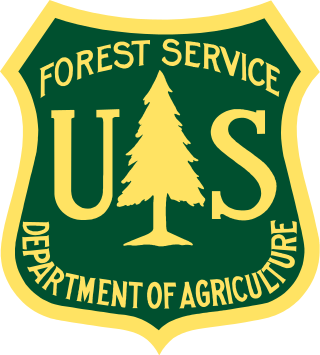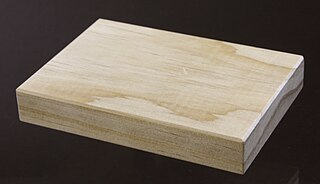Science education is the teaching and learning of science to school children, college students, or adults within the general public. The field of science education includes work in science content, science process, some social science, and some teaching pedagogy. The standards for science education provide expectations for the development of understanding for students through the entire course of their K-12 education and beyond. The traditional subjects included in the standards are physical, life, earth, space, and human sciences.

The Forest Products Laboratory (FPL) is the national research laboratory of the United States Forest Service, which is part of USDA. Since its opening in 1910, the FPL has provided scientific research on wood, wood products and their commercial uses in partnership with academia, industry, tribal, state, local and other government agencies. The laboratory is headquartered in Madison, Wisconsin. The focus of the Forest Products Laboratory is to promote healthy forests and forest-based economies through the efficient, sustainable use of the Nation's wood resources.
Biorefining is the process of "building" multiple products from biomass as a feedstock or raw material much like a petroleum refinery that is currently in use.

Claes-Göran Sture Granqvist is a materials physicist and Professor of Solid State Physics at Uppsala University in Sweden. Granqvist is considered a pioneer and expert in photochromic materials and energy-efficient building materials such as glass, paint, and wood.

Institute of Minerals and Materials Technology (IMMT) is an advanced research institute in the field of mineralogy to materials engineering, established in Bhubaneswar, Odisha. It was established in 1964 by the Council of Scientific and Industrial Research (CSIR), New Delhi. The main focus area of research of IMMT is mining and mineral/bio-mineral processing, metal extraction and materials characterization, process engineering, industrial waste management, pollution monitoring and control, marine and forest products development, utilization of medicinal and aromatic plants, colloids and Materials Chemistry and environmental sustainability. Dr. Ramanuj Narayan is the Director of this Institute at present where 140 scientists are working towards nation building programme.

Behara Seshadri Daya Sagar also known as B. S. Daya Sagar is an Indian mathematical geoscientist specializing in mathematical morphology. He is a professor of computer science at the Indian Statistical Institute, Bangalore. He is known as a specialist in mathematical morphology, fractal geometry. chaos theory, and their applications in geophysics, geographical information science, and computational geography. The Indian Geophysical Union awarded him the Krishnan Medal in 2002. He is the first Asian to receive the Georges Matheron Lectureship in 2011. In 2018, he received the IAMG Certificate of Appreciation by the International Association for Mathematical Geosciences for his work on the Handbook of Mathematical Geosciences. In 2020, Sagar was selected as an IEEE Distinguished Lecturer (DL) to represent the IEEE Geoscience and Remote Sensing Society. He, with Frits Agterberg, Qiuming Cheng, and Jennifer McKinley, led the monumental project on the Encyclopedia of Mathematical Geosciences to the completion. The first edition of two-volume 1756-page Encyclopedia of Mathematical Geosciences was published on 21 June 2023 by Springer International Publishers.

Walter Liese was a German forestry and wood researcher and wood biologist.

Anandharamakrishnan Chinnaswamy, commonly referred as Anandharamakrishnan is an Indian scientist and academician, having expertise in Chemical Engineering and Food processing. He is working as Director of National Institute of Interdisciplinary Science and Technology, (NIIST) Trivandrum. Earlier, he served as Director of National Institute of Food Technology, Entrepreneurship and Management, Thanjavur (NIFTEM-T) (Formerly known as Indian Institute of Food Processing Technology, Thanjavur, Tamil Nadu during the period April 2022 – November 2022 and as Chief Scientist at the CSIR - Central Food Technological Research Institute, Mysuru.

The International Academy of Wood Science (IAWS) is an international academy and a non-profit assembly of wood scientists, recognizing all fields of wood science with their associated technological domains and securing a worldwide representation.

Acetylated wood is a type of modified wood that is ecologically friendly and does not contain toxic substances. It produced from a special chemical treatment (acetylation) involving acetic anhydride and a chemical modification process to make wood highly resistant to biological attacks by fungi and wood-boring insects, ensuring a long lifespan and durability in various environmental conditions. It is a novel wood product in the field of wood science, following several decades of research and experimentation.
John Ralph is a New Zealand-born, American chemist, wood scientist, and professor at the University of Wisconsin-Madison.

Raymond A. Young is an American materials researcher, wood scientist and emeritus professor at the University of Wisconsin-Madison, who is an elected fellow (FIAWS) of the International Academy of Wood Science.

Holger Militz is a German wood scientist and professor at the University of Goettingen, who is an elected fellow (FIAWS) of the International Academy of Wood Science.

Peter Niemz (1950) is a German-born Swiss materials engineer, retired wood scientist and emeritus professor of the Institute of Building Materials at ETH Zurich, who is an elected fellow (FIAWS) of the International Academy of Wood Science.

Thujaplicinol is either of two isomeric tropolone-related natural products. They are found in tree species primarily in bark, needles, xylem, of the family of Cupressaceae like the Cupressus, Thuja, Juniperus and Thujopsis. The thujaplicinols are structurally equivalent to the thujaplicins with an additional hydroxyl group. They belong to the class of natural terpenoids having two free hydroxyl groups at C3 and C5 position.

Dick Sandberg is a Swedish mechanical engineer and wood scientist at the Luleå University of Technology, who is an elected fellow (FIAWS) of the International Academy of Wood Science.

Alfred Teischinger is an Austrian wood scientist and technologist and emeritus professor at the University of Natural Resources and Life Sciences (BOKU), who is an elected fellow (FIAWS) of the International Academy of Wood Science.

Gerald Koch is a German wood scientist and professor, senior researcher and research scientific director at the Thünen-Institute of Wood Research at Hamburg, who is an elected fellow of the International Academy of Wood Science.
Edmone Roffael (1939–2021) was a Palestinian-German chemist and wood scientist, and former professor at the Georg-August University of Göttingen, who made noteworthy contributions to clarifying the release of formaldehyde from particleboard and MDF products, and its emission reduction.
Josef Franz Gierer is an Austrian-born Swedish emeritus professor of organic chemistry and wood scientist specializing in lignin research, who is a member of the International Academy of Wood Science and honorary recipient of the Anselme Payen Award.





























